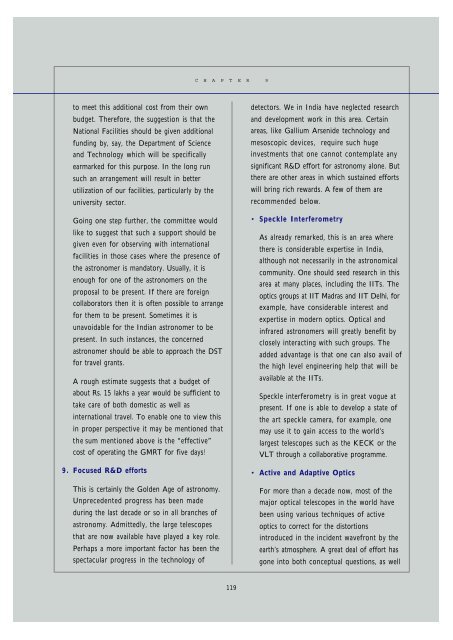2004 ASTRONOMY & ASTROPHYSICS - Indian Academy of Sciences
2004 ASTRONOMY & ASTROPHYSICS - Indian Academy of Sciences
2004 ASTRONOMY & ASTROPHYSICS - Indian Academy of Sciences
You also want an ePaper? Increase the reach of your titles
YUMPU automatically turns print PDFs into web optimized ePapers that Google loves.
CHAPTER 9<br />
to meet this additional cost from their own<br />
budget. Therefore, the suggestion is that the<br />
National Facilities should be given additional<br />
funding by, say, the Department <strong>of</strong> Science<br />
and Technology which will be specifically<br />
earmarked for this purpose. In the long run<br />
such an arrangement will result in better<br />
utilization <strong>of</strong> our facilities, particularly by the<br />
university sector.<br />
Going one step further, the committee would<br />
like to suggest that such a support should be<br />
given even for observing with international<br />
facilities in those cases where the presence <strong>of</strong><br />
the astronomer is mandatory. Usually, it is<br />
enough for one <strong>of</strong> the astronomers on the<br />
proposal to be present. If there are foreign<br />
collaborators then it is <strong>of</strong>ten possible to arrange<br />
for them to be present. Sometimes it is<br />
unavoidable for the <strong>Indian</strong> astronomer to be<br />
present. In such instances, the concerned<br />
astronomer should be able to approach the DST<br />
for travel grants.<br />
A rough estimate suggests that a budget <strong>of</strong><br />
about Rs. 15 lakhs a year would be sufficient to<br />
take care <strong>of</strong> both domestic as well as<br />
international travel. To enable one to view this<br />
in proper perspective it may be mentioned that<br />
the sum mentioned above is the “effective”<br />
cost <strong>of</strong> operating the GMRT for five days!<br />
9. Focused R&D efforts<br />
This is certainly the Golden Age <strong>of</strong> astronomy.<br />
Unprecedented progress has been made<br />
during the last decade or so in all branches <strong>of</strong><br />
astronomy. Admittedly, the large telescopes<br />
that are now available have played a key role.<br />
Perhaps a more important factor has been the<br />
spectacular progress in the technology <strong>of</strong><br />
detectors. We in India have neglected research<br />
and development work in this area. Certain<br />
areas, like Gallium Arsenide technology and<br />
mesoscopic devices, require such huge<br />
investments that one cannot contemplate any<br />
significant R&D effort for astronomy alone. But<br />
there are other areas in which sustained efforts<br />
will bring rich rewards. A few <strong>of</strong> them are<br />
recommended below.<br />
• Speckle Interferometry<br />
As already remarked, this is an area where<br />
there is considerable expertise in India,<br />
although not necessarily in the astronomical<br />
community. One should seed research in this<br />
area at many places, including the IITs. The<br />
optics groups at IIT Madras and IIT Delhi, for<br />
example, have considerable interest and<br />
expertise in modern optics. Optical and<br />
infrared astronomers will greatly benefit by<br />
closely interacting with such groups. The<br />
added advantage is that one can also avail <strong>of</strong><br />
the high level engineering help that will be<br />
available at the IITs.<br />
Speckle interferometry is in great vogue at<br />
present. If one is able to develop a state <strong>of</strong><br />
the art speckle camera, for example, one<br />
may use it to gain access to the world’s<br />
largest telescopes such as the KECK or the<br />
VLT through a collaborative programme.<br />
• Active and Adaptive Optics<br />
For more than a decade now, most <strong>of</strong> the<br />
major optical telescopes in the world have<br />
been using various techniques <strong>of</strong> active<br />
optics to correct for the distortions<br />
introduced in the incident wavefront by the<br />
earth’s atmosphere. A great deal <strong>of</strong> effort has<br />
gone into both conceptual questions, as well<br />
119
















